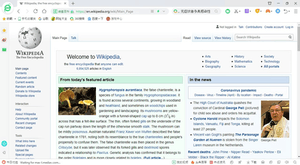360 Secure Browser
360 Secure Browser or 360 Safe Browser[5] (Chinese: 360安全浏览器) is a web browser developed by the Qihoo company of Beijing, China.[6][7] It was first released in September 2008.[6]
 | |
 360 Secure Browser on Windows 10 | |
| Developer(s) | Qihoo 360 |
|---|---|
| Initial release | September 2008 |
| Stable release(s) | |
12.3.1001.0.0[1]
/ June 5, 2020 | |
| Preview release(s) | |
| Engine | Blink, Trident |
The browser by default renders the webpage using the WebKit-based engine adapted for Google Chrome, Blink, and when running in compatibility mode, it renders webpages using the Trident engine found in Internet Explorer.[8][9]
World version
In early 2014 Qihoo released a global version of its web browser.
Market share
In January 2011, Qihoo claimed that it was the second most popular web browser in China (after Internet Explorer),[7] with 172 million monthly active users, 44.1% of Internet users in China.[10] Independent sources claim that the true figure is between 2-7%.[11] In November 2014 StatCounter reported that the Qihoo browser was the 5th most popular browser in the United States.[12] Its main competitors in China are the Sogou High-Speed Browser (Chinese: 搜狗高速浏览器) by Sogou, CM Browser (Chinese: 猎豹安全浏览器) by Cheetah Mobile, QQ Browser (Chinese: QQ浏览器) by Tencent, Baidu Browser (Chinese: 百度浏览器) by Baidu.com and Maxthon.
As of 2017, the latest versions of 360 Secure Browser do not offer a distinguishable user-agent string. It spoofs itself either as Google Chrome or Internet Explorer, making it difficult for developers to target or identify.[8]
Controversies
In 2012, a whistleblower reported a hidden backdoor in 360 Secure Browser. The Product Director of 360 Secure Browser, Tao Weihua, responded that "Whoever has a mind to beat a dog will always be able to find a stick" and accused the whistleblower of "smearing 360 on behalf of Baidu", which the whistleblower said was "the worst professional response in history". Independent analysis of the claim showed that the browser has an "undeclared mechanism (i.e., via ExtSmartWiz.dll) which connects to the server on a regular basis (e.g., every 5 minutes), and allows it to download files of any type (including executables) from the server."[13]
This and other controversies surrounding Qihoo eventually led to the temporary pulling of their products from the iOS App Store.[14]
High usage numbers may be due to the browser being difficult to uninstall, its parent product 360 Safeguard frequently recommending it and a warning pop-up that appears when a user attempts to install another browser, claiming that the other browser is unsafe and should not be run.[15][16]
See also
References
- "【版本更新】安全浏览器12.3最新版尝鲜". Retrieved 2020-06-05.
- "【SE10.1Beta版6月5日更新】360小程序闪亮登场!!!". 360社区. 2019-10-25. Retrieved 2020-04-09.
- "【极速11正式版——5月31日更新】升级至Chromium 69内核,三套全新皮肤". 360. 2019-11-15. Retrieved 2020-04-09.
- "【版本更新】安全浏览器12.2来了". 360. 2020-06-12. Retrieved 2020-06-10.
- "360 Safe Browser - Safe, Fast, Stable". browser.360.cn. Retrieved 2018-03-21.
- "Qihoo Formally Launches Web Browser Product In China". ChinaTechNews.com. Asia Media Network. Retrieved 22 July 2015.
- Gaskins, Francis. "IPO Pick of the Week: Qihoo 360 Tech". Seeking Alpha. Seeking Alpha Ltd. Retrieved 22 July 2015.
- Schaefer, Kendra (15 Jun 2015). "Qihoo 360 Secure: The Most Popular Browser You've Never Heard Of". Web Design Envato Tuts+. Retrieved 2017-06-21.
- processZ (产品经理) (2016-07-15). "360安全浏览器帮助中心". 360社区 (in Chinese). Retrieved 2017-06-21.
- "Amendment No. 2 To Form F-1 Registration Statement". U.S. Securities And Exchange Commission. U.S. Securities And Exchange Commission. Retrieved 22 July 2015.
- "Top 6 Desktop, Tablet & Console Browsers in China from Jan 2012 to Jan 2013". StatCounter.com. StatCounter. Retrieved 22 July 2015.
- Bott, Ed. "Weird science: How shaky web usage reports distort our view of tech markets". ZDnet. CBS Interactive. Retrieved 22 July 2015.
- Intelligence Defense Friends Laboratory (November 25, 2012). "Independent Report on Alledged [sic] "Hidden Backdoor" in Qihoo 360 Secure Browser" (PDF). Archived from the original (PDF) on March 27, 2014. Retrieved June 21, 2017.
- Obel, Mike (2013-04-09). "Privacy Issues With China's Qihoo 360 Technology, Which Provides Free Antivirus Software, Are Becoming More Public; But Qihoo Strongly Rebuts Accusations". International Business Times. Retrieved 2017-06-21.
- Millward, Steven. "9 Evil Tactics Used by 360 Safe Browser to Beat IE in China". Tech in Asia. Tech in Asia. Retrieved 22 July 2015.
- Pierce, Doug. "How Qihoo 360 Won the Browser War in China". Digital Due Diligence. Digital Due Diligence. Archived from the original on 23 July 2015. Retrieved 22 July 2015.